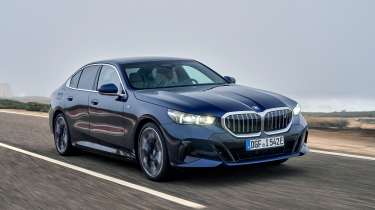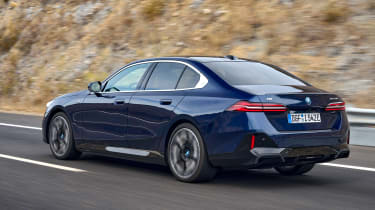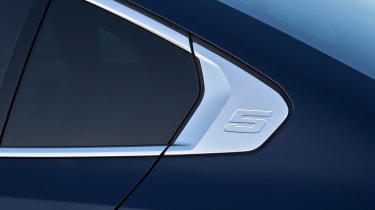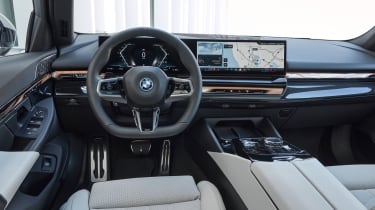BMW i5 eDrive40 2023 review – an emphatic answer to the Mercedes EQE
BMW’s electric 5 Series demonstrates that EVs don’t have to reinvent the wheel for the sake of being different.
We like BMW’s i4, it feels as close to a 3-series as you can get without an ICE motor primarily because it’s just that: an electrified 3-series (4-series Gran Coupe if we’re being pedantic). Built on the same Cluster Architecture (CLAR) as the internal combustion engine models, rather than reinventing the wheel as so many EVs do, BMW took the decision that ICE and EV models should feel indistinguishable from each other, hence why the i4 impresses so much.
BMW’s new i5 follows the same path as its smaller sibling by simply being part of the new 5-series family rather than a standalone electric model. As a consequence, like the i4, it instantly appeals to those who care little about legacy manufacturers trying to reinvent themselves as something they clearly can never be (tech companies, mobility solutionists) while ignoring what it is they actually are: huge, global manufacturing companies that make cars using metal, rubber, plastic and glass. As well as those who like their EVs built to an impeccable standard that drive without compromise compared to an ICE equivalent.
BMW has always had the confidence to stick to what it knows best and do it better than others, and its movement into the electric vehicle sector is no different. That it has also not given a date for when it will stop the manufacture of internal combustion engines also shows a level of pragmatism and wider foresight than others who have already condemned their ICE divisions to history. “ICE and BEV powertrains will be offered in all BMW models and will coexist for at least for the next 10 to 15 years” explained Frank Weber, BMW’s Member of the Board of Management for Development at the i5’s launch.
More reviews
“We will challenge politics. Ask: “What have we done for the green economy? We need to have pure green energy. Ask what have we done for the BEV economy? We need to understand what has to be done to the electrical infrastructure to become a truly green BEV economy.” Green washing isn’t BMW’s thing, so don’t expect a flag in the sand end date for engine production any time soon.
Building good saloon cars is, and always has been, a BMW speciality, and the new 5-series is no different. Until the twin-turbocharged V8 hybrid M5 arrives in the late summer of 2024 there will only be one petrol engined 5-series offered in the UK: a 2-litre, turbocharged four-cylinder with mild-hybrid assistance. The diesel engines won’t leave the Continent but the two electric options will: a 335bhp eDrive40 and and the 600bhp M60 xDrive, with former rear-wheel drive and the latter distributing its power and torque to all four wheels. Unfortunately our drive of the M60 xDrive was brief and included a stretch of motorway and a Portuguese village, so we’ll revisit it later when we have more time.
It’s a big car, the i5. At over five-metres in length, 1.9-metres wide and sitting on a 2.9-metre long wheelbase, it’s on a par with a 2008 7-series. BMW claims the new 5 has the luxury of a 7 with the dynamics of a 3, but it surely doesn’t need to be as big as the former to deliver on its luxury targets, does it?
Traditionalists, and those who like their cars interiors to be functional rather than styled for the sake of a design ego, will find the i5 brilliantly comfortable and intelligently laid out, with materials that help justify the stiff £74,105 price tag. Yes, there are screens – two of them – and the heater controls are on one of them but thankfully they aren’t as ruinously bad as Volkswagen’s attempt.
There’s a chunky steering wheel to grip, and a centre console to operate the transmission and drive mode controls. It feels very BMW, simply configured, brilliantly executed.
A circa 2,200kg kerb weight doesn’t provide the BMW with performance punch, despite the 335bhp generated by the eDrive40’s rear motor. But it’s an exec saloon and not an M car, so therefore has the performance the majority of drivers will expect, bar those who have a questionable fascination with EV acceleration times.
There’s a great deal of sophistication to how the i5 drives. The silence from its powertrain delivers the calming luxury factor BMW was hunting for and while its performance isn’t going to trouble a Tesla, the ‘throttle’ pick-up from standstill is smart enough to keep ahead of the traffic and regardless of the road and scenario you find yourself, in the i5 eDrive40 doesn’t leave you holding out for more. For today’s world it has all the performance you need.
It’s not exciting to drive, because its size and bulk over an i4 can’t disguise themselves so you settle into a rhythm and flow more in keeping with an exec-saloon than a super-saloon. And it’s all rather agreeable as a result. Miles fly by, the suspension absorbs the surfaces beneath - although consistent surface imperfections do eventually find their way through to the cabin as all the mass can only be controlled to a point - but it’s never jarring, more a series of light vibrations for a split second before fading away.
When it comes to changing direction it’s crisp and clean with linear actions to the core controls, which is welcome due to the size of the car and the need to be precise when positioning it on the road. If you’ve spent any time in a 5-series – or any BMW saloon – you’ll feel right at home as to how the i5 drives. If you haven’t and you find EVs soulless and empty to drive, the i5 addresses some of these issues.
Range is claimed to be up to 361 miles and 205kW charging is possible, which means the i5’s 81.2kWh battery can be topped up from 10 to 80 percent in 30 mins. An 11kW onboard charger is standard, with a 22kW unit optional.
If you’re a fleet driver and have been holding out for an EV in this sector the i5 offers the strongest and most compelling proposition of them all, carrying on the strong work established by the impressive i4.
Price and rivals
It’s taken the world a while to produce exec-saloons with EV powertrains, the industry spending those first few years focussing on slinging batteries under SUVs to get to market as quickly as possible.
Therefore, competition for the i5 is still a bit thin on the ground. Mercedes-Benz’s EQE has an equivalent to the i5 eDrive40 in the shape of the 350 AMG Line at £77,345. Its 89kWh battery allows its motors to produce 288bhp and up to 375 miles of range, unless you tap into its 6.4-second 0-62mph time or 130mph maximum speed. To drive it’s a long way behind the BMW in terms of refinement, powertrain integration and quality.
Genesis has entered the market with its competitive G80 Electrified, which comes with an 87kWh battery that’s good for its front and rear motors to produce a combined 365bhp. Costing £69,905 it’s the most competitively priced saloon in the market.
Audi’s electrified A6 e-tron is still some way off, so you’ll need to look towards the e-tron GT at £86,135. The Taycan-based saloon offers 523bhp, which might be a trade off you’re willing to make against its more cramped interior. And of course there’s the left-hand drive only £93,000 Tesla Model S with its 661bhp and 394 mile range.








